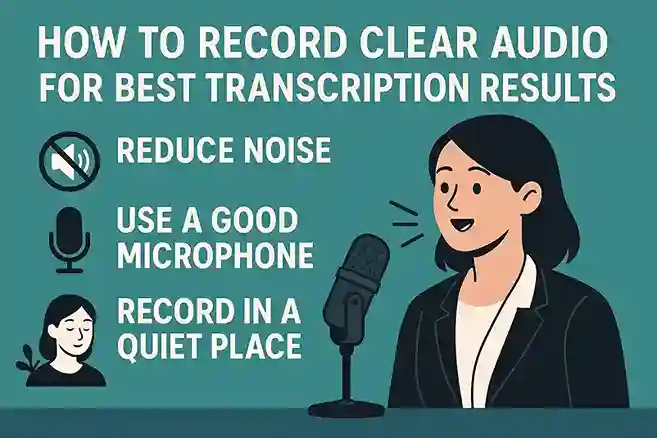
Imagine you have just finished recording an interview or an important meeting. Now you have uploaded the audio on your favourite transcription tool and asked it to convert it into text.
You start reading the transcript, and it results in a complete mess with jumbled sentences, misheard words, wrongly spelled names or even sentences with changed meaning. Frustrating to even imagine, right?
In such situations, we wonder what went wrong.
Let's address the elephant in the room: no matter how advanced your voice to notes app is, it can only work with what it hears.
This is why recording clear, high-quality audio is not just necessary but one of the most essential factors that affect the accuracy of your transcription.
In this blog, we will discuss everything you need to know to record clear audio so that next time you don't need to review or edit your transcripts for hours.
Why is Clear Audio important for Transcription?
Voice-to-Text tools, even powered with AI, are still not advanced enough to read minds. They rely on the clarity of the input voice. Clear speech at the right pace in a noise-free environment is what they love the most.
If your voice is accompanied by different background noises, with unwanted sounds, then even the most advanced speech recognition engine will struggle to convert it into clear text.
However, as discussed in detail about whether voice-to-text can replace manual typing, these tools continue to evolve and improve their accuracy rates significantly.
Clear Audio Helps to:
- Improve Accuracy Rate:
With high-quality and clear audio, you can get maximum accuracy as close as human transcriptionists. Tools like VoicetoNotes.ai and Fireflies.ai can achieve up to 99% accuracy with good-quality audio.
- Saves Time:
What if you don't need to edit your transcripts for hours or need just fewer edits?
This would save a lot of time and energy.
- Cost Reduction:
If you are using paid resources to transcribe and edit then multiple editing can be a challenge. Hence, with fewer errors, you can save not just time but also cost.
So, How to Record Clear Audio for Best Transcription Results?
Let's discuss how, with simple steps, you can ensure Clear Audio and achieve the best transcription results with high accuracy.
Step 1. Sit in a calm, quiet environment:
This is the most important step. You must have seen how tough it is to hear anything in a loud noise, even for humans, so how can your voice transcription app work in a loud, noisy environment?
Avoid:
- Rooms with noise of traffic, construction or even electronic devices.
- Open halls where your voice echoes.
- Public areas like metro stations, cafes have constant sources of sound.
Prefer:
- Always remember to close doors and windows.
- Sit in bedrooms or carpeted rooms as they can absorb sound.
- Prefer small spaces with soft furniture.
Step 2. Use the Best Quality Mics:
Let's break the myth that audio quality is not dependent on fancy microphones. The mic affects the voice quality to a large extent.
If you are using:
- A simple smartphone: Keep the phone 6 to 10 inches away from your mouth and keep it stable without any movement.
- Clip-on mic: If a small investment can save you from unwanted errors, then it's definitely worth it. These will cost you as little as $10, and you can attach them to your shirt for close ranges.
- USB Microphone: If you are a content creator or podcaster, then this becomes crucial. You can just plug into your laptop and record via tools like Audacity.
Tip: Avoid built-in mics of laptops as they are too far from your mouth and sensitive to background hiss.
Step 3: Remove all Background Noises:
Make sure to check the following things before you start recording:
- Switch off any electronic devices like TV, Fans, ACs, and kitchen appliances.
- Close all doors, windows and put curtains to block outside noises.
- Put your phone on silent mode to avoid notifications ringing.
- Make sure to record while you are alone or request others to stay silent.
Even the small buzzing sound can become noticeable during recording.
Step 4: Speak in a Moderate Pace with a Clear and Calm Voice:
Transcription apps are designed to register sounds at a moderate pace and can't hear mumbled thoughts. They can't listen to voices that are too slow or too fast. So what to do?
- Speak at a slow but natural pace without sounding robotic.
- Take brief pauses between important points and different sentences to ensure correct punctuation.
- If there are multiple speakers involved, avoid overlapping or interrupting. Instead, speak one at a time.
- Don't use words like uh, like as it can confuse the system.
Pro tip: Avoid heavy accents, fast-paced speaking or whispering. Just speak confidently and clearly.
Step 5: Use High Quality Transcription App:
Though most devices come with built-in recording apps for casual notes, these are prone to errors. For transcription, you need a powerful app that provides high-quality output.
To help you make the right choice, here's a comprehensive guide to the best voice to notes apps available today that can deliver accurate and reliable transcription results.
Features to look for:
- High-quality output (Waveform audio file format or MP3, at least 256 kbps).
- Apps that have noise reduction options.
- Apps that provide cloud syncing.
Top Apps that you can consider:
- VoicetoNotes.ai:
- Otter.ai:
- Fireflies.ai:
Step 6: Take a Test Before You Start:
Every app is designed differently and no app can work for all. So you have to decide what works for you the best? It can not only save you hours but also your money before you buy a subscription. Here is how you can test the app:
- Install the app.
- Log in to it with your email account.
- Give the required permission and hit the record button.
- Ask simple questions like
- Check the transcripts; if it's error-free, you are good to go.
Step 7: Check for file format:
The format of your audio is very important to ensure the right transcription. Some apps compress the audio file such that it becomes fuzzy and unclear.
- Always go for the WAV format.
- Avoid ultra-compressed formats like MP3 64kbps.
- M4A fits for smartphones but is not compatible with all transcription apps.
So by following these 7 simple steps, you can ensure good audio quality and get the best transcription results.
How to ensure Audio Clarity in case of Group Recordings?
Recording meetings, interviews and even podcasts in case of multiple speakers poses a challenge to ensure Clear Audio. But by keeping a few things in check this challenge can be overcome.
- Ask for the introduction of speakers at the beginning of the recording only.
- Either provide a single mic per speaker or keep recording devices at an equal distance from all.
- Avoid overlapping or interruptions between conversations.
- If working remotely, ask each speaker to record at their end.
AI tools like VoicetoNotes.ai can detect and label speakers with clear and consistent audio.
Conclusion:
To ensure the best transcription results, you don't need to be an audio maverick but a good quality transcription app, a little bit of preparation and maintaining peaceful surroundings.
You are just a few steps away from getting an error-free, well-written transcript. Whether you are documenting a meeting, preparing for a podcast or transcribing a lecture, clear audio can change the whole workflow.
So next time, before recording, make sure to mark the checklist of the above steps and see your transcription apps doing magic.
FAQs
Which is the best audio format for transcription?
Uncompressed audio formats like PCM, WAV, which keep the audio as it is, are the best for transcription. Lossy formats like MP3 at 253 kbps are also good due to their smaller size.
How to transcribe audio to text effectively?
- Choose a peaceful environment.
- Before recording make sure to eliminate all kinds of noises.
- Use a good-quality mic.
- Use a transcription app of your choice. Install it and log in to it.
- Hit the record button, and your transcript is ready.
What is the Best Audio to Text Transcriber?
The best tool depends on your usage. Transcription apps like VoicetoNotes.ai, Otter.ai, Notta, and Fireflies.ai are some of the popular apps.
How do you transcribe your audio for free?
Well, the in-built transcription tools in phones are free to use, but they struggle with accuracy. You can use apps as per your choice and try them to see which suits you best.
